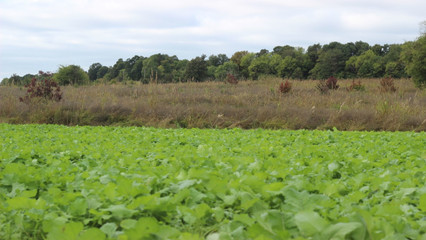To Plot or Not: Are Deer Food Plots worth the Effort?
Posted by Drew Palmer on Aug 14th 2022
One of the newest trends in hunting and outdoor stewardship is the planting of what we call “food plots.” Planting food plots for hunting can increase a hunter’s odds of success and provide important nutrients to wildlife during critical times of the year. But it isn’t strictly necessary—hunters have done without for thousands of years and so have the wildlife.
If you’ve never planted a plot, know this: it is without doubt a time-consuming, frustrating labor of love that can bring great pain but can also provide sheer joy and satisfaction.
What to Expect from a Food Plot
Modern day agricultural practices have humans planting more acres than ever with a higher yield and more efficient harvest percentage to match. That being said, the plots you plant cannot sustain a population. Food plots are meant to entice and up your odds at the game.
To put it into perspective, one deer consumes 1.5 tons of food per year. That’s the equivalent of 300,000 red oak acorns or 9 million soybeans. And with a deer density of 15–25 per square mile across the Midwest, feeding an entire population of deer (without even adding other wildlife into the equation) is next to impossible with the average hunter’s food plots.
The Different Types of Food Plots
Different types of food plots serve different purposes and the way you use them can be as crucial as what you plant in them. Variety in both, if you can do it, will give you options for different times of the year including early versus late season or even during the rut.
Winter plots are by far the most important and beneficial type of food plot you can plant, as they provide late-season hunting opportunities you might not have without them. The top reason for planting a winter food plot is providing wildlife an easier-to-find food source than what is typically available in the dead of winter.
Some plots are best left untouched entirely, offering food that is safe and under no pressure whatsoever, especially if it’s in the middle of the property. This will allow you to hunt the edges of your property, usually on smaller and more strategically placed plots that bucks like to frequent just before dark, often called “staging” or “kill” plots.
These smaller areas seem to give those mature bucks a sense of security and this is what many hunters use just a few hundred feet or yards from their main food source. Being able to manipulate a property by adding a plot centered around the perfect tree, if you’re able, can make all the difference.
The Best Crops to Plant in Your Food Plot
When planting their plots, every landowner or steward should have certain goals in mind, taking into account their access to equipment and tillable acres.
Summer versus fall or perennial versus annual? The debate on what to plant in your food plot goes on. There is a never ending supply of seed mixtures, seed brands, and crop types for nearly all times of the year to choose from. From standing grains to greens, folks have tried it all to bring wildlife out into the open.
Grains grain crops will almost always be better than other crops and the critters love them in late season. But they are also the most expensive to plant and nurture to a beneficial stage, often requiring additional fertilizer or electric fencing. If you are able, ask your farmer to leave some standing grains.
The poor man’s plot often contains greens such as rye, wheat, or turnips, as they grow easily and will have attractive value for those deer. Just as commonly, baiting (if legal where you are) is another substitute for plots depending on your budget and property.
A Labor of Love
The opportunities offered by the different kinds of food plots are endless, if you have the desire and drive to create them.
Planting a food plot for hunting is a labor of love and entirely unnecessary, and yet we plant thousands of acres yearly for this sole purpose. Yes, the reason you tell yourself you’re doing it is for the wildlife and for better opportunities to successfully harvest wildlife, but it’s just as much for a sense of personal accomplishment. And that’s all right.




